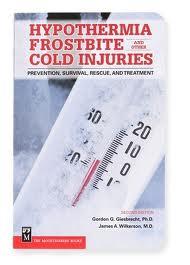Stayin' Alive
Hypothermia, Frostbite and Other Cold Injuries: Prevention, Survival, Rescue, and Treatment (Second Edition)
by Gordon G. Giesbrecht, Ph.D., and James A. Wilkerson, M.D.
excerpt pages 125-126
The backcountry in winter is a fantastic place, but it can also be one of the most dangerous. If you spend a lot of time out there, you need to read Hypothermia, Frostbite and Other Cold Injuries: Prevention, Survival, Rescue, and Treatment (Second Edition) (The Mountaineer Books; $18) because it may save your life or another person's life. At the least, it will teach you how to know when to stop and get warm. The book explains in detail the physiology of getting cold, which will help you recognize the signs of hypothermia, frostbite, or a myriad of other cold-weather problems in time to avoid a catastrophe.
Below is an excerpt from the book. It's about what to do if you've fallen through ice. We hope you read it and remember it.
[EXCERPT]
Most people have a poor understanding of how their body reacts during ice water submersion. The following principles are based on the easy-to-remember slogan "One Minute—Ten Minutes—One Hour." Although individuals vary in the timing of events, the principles apply to everyone.
One minute to get breathing under control. Uninformed people think they can die of hypothermia within only a few minutes of ice water immersion, and tend to panic, which must be avoided. The first priority is to get breathing under control so that gasping and hyperventilation do not result in gulping water or even drowning. Slow deep breaths are best.
Ten minutes of meaningful movement. Once breathing is under control, an individual must try to get out of the ice water as quickly as possible, usually needing a burst of energy to do so. In cold water, loss of arm control and loss of the ability to gasp is progressive, and this deficit is substantial within the first ten minutes. The person should take time to determine where the ice is most likely to hold the body's weight, which is usually near the point of immersion. After putting arms up on the ice, the individual should keep the face close to the ice to keep the upper body low (kiss the ice), kick the legs until the body is horizontal, then kick vigorously and pull the body up onto the ice. Once on the ice, the person must roll away from the hole, and not stand up. If the person is close to the shore, it may be possible to roll all the way to the shore. If the incident occurred farther from the shore, the individual should not stand up until the ice is thick enough to support the weight.
When safely away from the hold, the individual must immediately work to get water out of clothing and make a decision about whether to go to safety or prepare to stay and wait for rescue.
One hour before becoming unconscious due to hypothermia. If individuals cannot get out of the ice-cold water within ten to fifteen minutes they must recognize that, although they might not yet be hypothermic, physical incapacitation continually gets worse. Although self-rescue may no longer be possible, the individual can still remain conscious for an hour or more. Appropriate action must be taken to extend survival time and widen the window of opportunity for rescue.
Individuals should place their arms on the ice and lay their heads on their arms to reduce the chance of sliding backwards in to the water if their heads should fall backward. They must stop struggling, as this only increases heat loss and quickly results in exhaustion. The arm may freeze to the ice, which would keep the person's airway above water if consciousness is lost. In more temperate conditions—such as during spring break-up—arms may not freeze to the ice, but minimizing movement should still prevail.
If an immersed individual is wearing a snowmobile helmet and it can be taken off easily, it can provide up to twelve pounds of buoyancy, almost as much as a certified personal flotation device (PFD).
Clothing should be kept on while in the water, as clothes help conserve body heat, and the air trapped inside initially provides buoyancy. Water eventually replaces the trapped air, but wet clothing does not pull an individual down. Even though up to eighty pounds (36 kg) of water can be absorbed by the clothing, this water has the same density as water outside the clothing and does not pull the victim beneath the surface. The water in the suit does not have significant inertia, making it difficult to move arms and legs in the water, but the greatest difficulty with water in clothing is encountered during exit when the weight must be raised above the water surface.











